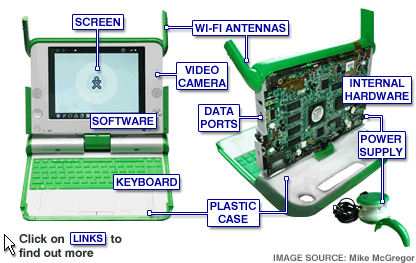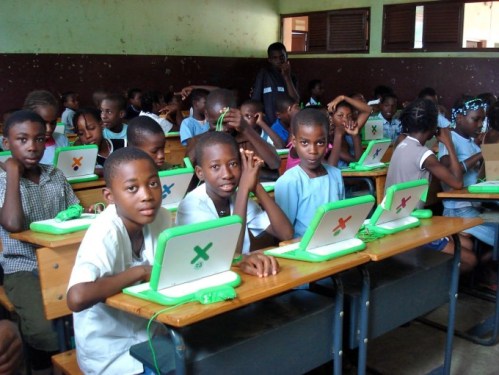

Where did the idea of One-Laptop-Per-Child (OLPC) originate?
In the early aughts of the 21st century, the cost of a laptop ran close to $1000. The idea of producing one that would sell for $100 and be sent to children in Latin America, Africa, and Asia who may or may not have had a schoolhouse or teacher caused giggles among tech engineers, entrepreneurs, and venture capitalists. A contemporary of Seymour Papert and head of a center at Massachussetts Institute of Technology (MIT), Nicholas Negroponte believed that cheap, durable, and Internet-connected machines could revolutionize teaching and learning. He told conferees in 2010:
One the things people told me about technology, particularly about laptops in the beginning, “Nicholas, you can’t give a kid a laptop laptop that’s connected and walk away.” Well you know what, you can. You actually can. And we have found that kids in the remotest parts of thew world, when given that connected [laptop], like some of the kids in these pictures, not only teach themselves how to read and write, but most importantly, and this we found in Peru first, they teach their parents how to read and write.
OLPC launched in 2006-2007 and the price was around $150 per laptop but crept up to just over $200 over the next few years. Negroponte contracted with ministries of education in various countries to buy laptops.
What is OLPC?
The hardware and software of the initial laptops distributed in Nigeria, Uruguay, and later Peru, Rwanda and other developing nations was simple enough:

The rugged, low-power computers use flash memory instead of a hard drive, run a Fedora-based operating system and use the SugarLabs Sugar user interface…. Mobile ad hoc networking based on the 802.11s wireless mesh network protocol allows students to collaborate on activities and to share Internet access from one connection. The wireless networking has much greater range than typical consumer laptops [of those years]. The XO-1 has also been designed to be lower cost and much longer-lived than typical laptops.

Depending upon the country, ministry officials distributed the devices to children directly in villages and towns and in rural and urban schools between 2007-2014. OLPC came to the U.S. in 2008.

What problems did OLPC seek to solve? Massive poverty in economically developing countries was the chief problem. Education was the solution. But building schools and providing teachers was costly. Children and youth were motivated to learn but lacked access to schools. And where schools were available, tuition and inadequately trained teachers often made education a rote-filled sequence of lessons resulting in high student attrition. OLPC connected to the Internet was seemingly a solution to problems of limited access to schooling and traditional teaching by permitting students to use software to acquire knowledge and cognitive skills in a variety of subjects beyond memorizing lessons. The belief that increased access to schools, teachers, devices, and the like would break the shackles of poverty continues.
Or as the OLPC project said:
We aim to provide each child with a rugged, low-cost, low-power, connected laptop. To this end, we have designed hardware, content and software for collaborative, joyful, and self-empowered learning. With access to this type of tool, children are engaged in their own education, and learn, share, and create together. They become connected to each other, to the world and to a brighter future.
Negroponte believed that children could be “agents of change” to create their own learning with these laptops (see video of Negroponte talking about OLPC in Afghanistan here).
Did OLPC work?
Amid that optimism, the issue of putting the devices into hands of teachers and students–implementation–was given short shrift. Without careful thought and action on Internet-connected devices and software into hands of teachers and students (or children and youth not in school), any definition of “work” becomes suspect. There was a magical belief in OLPC, like a fairy Godmother turning a pumpkin into Cinderella’s carriage to take her to the ball.
How teachers were to use the laptop or how students were to magically learn led one skeptic to put it this way:

If “work” means that students used the devices until they wore out or had to be trashed because once broken they could not be fixed, then OLPC “worked.” But if “work” means that students learned more, faster, and better (as measured by existing national tests or other metrics of academic achievement) available evidence is close to nil (see here, here, and here). And if “work” means as the founders sought, that is, With access to this type of tool, children are engaged in their own education, and learn, share, and create together, no evidence of such grand dreams for OLPC exists.
What happened to OLPC?
OLPC exists today. It is a small operation with projects in Africa, Asia, and Latin America (see here and here).
The details of the splitting apart of OLPC into two organizations since 2008, the departure of the founders including Negroponte, the constant searching for new contracts in Latin America, Africa, and Asia, and the shell of the once expansive organization that continues to exist now is described here, here, and here.
Did OLPC fail? Succeed? Depends on how “success” and “failure” are defined, who does the defining, and the criteria used to make the judgment.

I was in Haiti a few years back at a school and they had received a shipment of laptops, though I don’t recall if it was from OLPC or a Gates Fdn effort. At any rate, they were still in the boxes because there was not enough electricity to plug in all the devices to charge them up.
David, thanks for comment.
I recall being enchanted with the design of the computer with grips, foldout antennae, and more. The infrastructure to support the devices was not in place, and there were problems with sand, humidity, and other hazards.
Fast forward.
The current version of tech and curriculum and teaching tools for low income families can be seen in the for-profit Bridge International Academies with a complete system of scripted education delivered with mobile phone technology. That is the main tech tool that the BIA franchise offers to teachers but it is loaded with software sufficient for full financial accountability, performance measures for students and teachers, with information needed to managing supply chains, and site selections for schools. This for-profit operation is funded by a mix of public and private investors http://globalinitiative-escr.org/wp-content/uploads/2018/02/List-of-BIA-investors.pdf
Here you can see C-span session that also serves as a marketing pitch for Bridge International Academies. The American Enterprise Institute used c-span to help market Bridge International in Liberia as a “world class education.” A future teaching aid may be a cardboard holder for a mobile phone and an app that, transforming the phone, placed in a cardboard holder, into a virtual reality headset. The idea is that the device enables students to see, for example, a science lab experiment in an environment where no science labs are available.
https://www.c-span.org/video/?430887-1/charter-schools-developing-countries&start=1621 The description begins about 00:47:31.
Here you can see the low cost teaching aids and curriculum materials for students in BIA schools. I am reminded of the improvised resourcesand low-cost books in my elementary schools during WW II.
http://www.bridgeinternationalacademies.com/academics/tools/
This link will show the complete system of education engineered from the USA, with financial accounting built-into the model.
http://www.bridgeinternationalacademies.com/approach/lifecycle/
Here are some of the criticisms of the Bridge International Academy system. The criticisms are directed to non-profit funds flowing into a for-profit venture and the billionaires who are funding BIA for profits, including some well-known players from the United States.
http://www.hakijamii.com/index.php/2018/04/23/independently-verified-facts-about-bridge-international-academies-by-113-signatories/
Thanks for your comments, Laura, especially on Bridge International Academies. Some of what you cited is familiar to me, not other links. So thank you. I wonder what you think of this post that Mike Goldstein wrote about BIA–he was chief academic officer of the organization for four years. See: http://blogs.edweek.org/edweek/rick_hess_straight_up/2017/11/puzzles_for_practitioners_in_the_developing_world.html
The whole concept strikes me as new-colonialism. The focus on test scores within nations is likely a colonial legacy. The questions–what would you do–strike me as pre-occupied with gains in test scores and some unwillingness to acknowledge that cultural contexts matter. They matter more than the pushers of a ready-to-use system–one not of indigenous or collaborative design–want to deal with.
Thanks for looking at the post, Laura, and commenting on it.
“Amid that optimism, the issue of putting the devices into hands of teachers and students–implementation–was given short shrift.”
Consider for a moment all the revolutionary and disruptive technologies that have been introduced over the last twenty years and how teaching has remained virtually impervious to change throughout this period. It’s not the technology. No matter how new, shiny, powerful, creative, or versatile the device, teachers will continue to teach the way they have always taught if there is no motivating reason to change.
So many tech initiatives in education fail because they focus on the technology and not pedagogy. Where schools so often fall short is that they don’t develop a galvanizing vision of how learning can be different and enhanced when technology is introduced.
Thanks for taking the time to comment, Tom.
May 6, 2108
Dear Larry and readers,
The idea that giving children and adolescents some instrument that they will use for their own education is absolutely ludicrous. Children and adolescents will use it just for fun. If some instructor orients them in class on using the device for some educational purpose, the access to the internet in school or at home will be a temptation to access inappropriate material for their age and local culture.
The internet presents three enormous problems for children and adolescents, which I find irrefutable: 1. Extremely high risk of causing addiction. A recent Common Sense Media research has shown that 52% of youngsters declared that they use the internet too much — that is, they recognize that they are addicted (and 66% of the parents found the same in relation to their children). (Note that any addiction releases dopamine in the brain, which gives the sensation of pleasure, and the risk of passing from one addiction to another is very high). 2. Extreme high danger of predators. All children and adolescents are naïve, they have not faced life as has an adult. e.g. with a family, as a professional the practice of filling an income tax declaration, and so on. 3. The internet is a free space, but children and adolescents should not have absolute freedom, they need to be oriented (and intuitively they know this). Very few people install control software for the use of computers and cell phones by their children. And this software is of limited efficacy.
See my old paper presented to the WCCE 2009 (IFIP World Conference on Computers in Education) ‘A critical view of the “One laptop per child” (OLPC)’ project’ on my web site with address below. At that time the internet was not the monstrous problem that it has become nowadays.
Cell phones and tablets have permitted the use of the internet in any place, at any time at any age. Thus, the attack on children and adolescents has become total. There are forces that are trying to destroy nature and humankind. Destroying children and adolescents is an efficient means of reaching that goal.
Cell phones became popular in 2004 and tablets in 2010. The Z- or millennial generation that has grown with them has not turned into adults yet. Nobody knows what’s going to happen with them. My forecastings are the worst possible (but there is a “Setzer’s Law” which says “The misery that the human being is able to create surpasses the worst pessimism”). This is an experiment that is being made with hundreds of millions of children and adolescents. This is a real crime. In my opinion, a teacher or parent who gives incentive to children and adolescents for using the internet is committing a crime against humankind.
Valdemar W. Setzer – Dept. of Computer Science, University of São Paulo
http://www.ime.usp.br/~vwsetzer – please REPLY TO vwsetzer@ime.usp.br
Thank you for your comment.
Dear Larry (and Valdemar)
You have both likely seen the latest worrying evidence for physiological damage to children’s brains from scree use. This is additional to any psychological damage that may also be occurring! https://www.technologyreview.com/f/614672/screen-time-might-be-physically-changing-kids-brains/
I found your discussion page because 10 years ago I wrote a critical piece on technology and innovation: http://pilot-projects.org/words/single/the-innovation-paradox-how-innovation-products-threaten-the-innovation-pro
and in it referenced the One Laptop Per Child endeavor. It came to mind tonight that I hadn’t checked in on the project for a long time and found this thread. (Larry I also cited you from Oversold and Underused in my article)
Anyway, glad to hear that there are more sound minds out there questioning some the tech obsession extending into every area of our lives!
Scott Francisco
pilot-projects.org
Thanks so much, Scott, for your extended comments on OLPC and issue of screen time for kids. Appreciate the links as well.